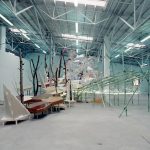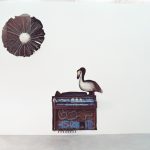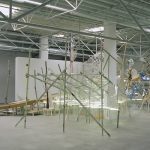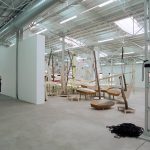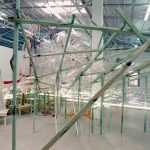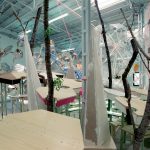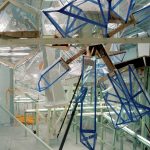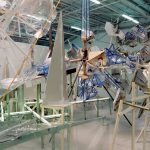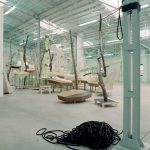Segmentation Cavity in Zero Gravity
Lathes, iron rods, acrylic glass, plasterboard, polyurethane foam, poplar trunks, adhesive tape, foil mirror, synthetic ropes, assorted coated chipboard, neon tubes, eöectric cables, straws, latex paint, varnish;5 x 10 x 9 m, variable Installation as part of the group exhibition “Halls in light and fresh jewellery” at Ausstellungshalle zeitgenössische Kunst Münstertogether with Kathrin Schlegel, curator: Gail Kirkpatrik Images 3 and 4: “Make Music – 45 Comments” Organ, stuffed swan, beheaded wine glass with tartar, synthetic sphere, branches, polyurethane foam, core-board; 3 x 6 x 0,80 m, 2005
Time and again, Gehlen confronts the viewer with an almost unmanageable accumulation of diverse materials and artistic form. The artist unites packaging and building materials from electronic devices, every day objects, lighting, extension leads, images from print media, computer drawings, diagrams etc. into his spatial installations, that appear chaotic but yet offer an underlying ordered system. Gehlen’s great artistic installation “Segmentation Cavity in Zero Gravity”takes up almost a third of the entire exhibition space and arouses images of a flying object that is about to land on the floor of the space. Its inner life is determined by a transparent plexiglas capsule that hovers above the ground.
A great many plastic elements made of wood and synthetics, wires and prismatic form accrue from and that radiate into the space. This is emphasized by the energetic light of the neon tubes integrated into the sculptural environment.In several stumps, that are located in the middle of Gehlen’s structure, the fantastic cosmos of Creation seems to get tangled up in the exhibition architecture as if an extraterrestrial force attempted to contact our world.
Gehlen is interested in the diversity of human systems, ways of thinking and awareness patterns that were established to form meaning out of chaos. Wishful thinking and high-tech knowledge, history and future trends, the lofty and mundane,dainty order and almost hysterical chaos run together into Gehlen’s artistic constructs.
At first sight, his two-piece installation for the Gallery of Contemporary Art in Münster acts like a brutal Horror Vacui full of sensuous impressions. And yet,after some time one discovers the distinct traces of a tightening and regulatory force, from its midst emanates a kind of harmonic beauty. The second part of Andreas Gehlen’s work titled “Make Music – 45 Comments” was created from symbolically charged things of the mundane: a broken organ, a stuffed swan,a beheaded wine glass and a construct resembling a stone made of twigs.
Gehlen integrates these objects into the cut-up wall within the exhibition space like three-dimensional jigsaw pieces;a wall that places itself between Gehlen’s display of installation work and the profance architecture of the former warehouse.Were these elements incorporated into the world of this life in Gehlen’s universe beyond of the separating wall or did they just detach and free themselves from Gehlen’s world?
Dr. Gail B. Kirkpatrick
THE FIRST PRECONDITION FOR IMMORTALITY IS DEATH*
The central theme in Andreas Gehlen’s work is man’s striving for his own comprehension of space and that of the elements defining it . By doing this he not only creates space as something abstract,but also as a reflection of a social construction; as a world model. The observer becomes involved in a system that is based on an awkward balance between microcosm and macrocosm. The question that comes involuntarily to one’s mind is whether we are a match for the depicted powers: vectors define space and determine the direction of an energy flow that is nourished by an accumulation of building materials and the refuse of an affluent society.Often abandoned by others, this material references the transitory nature of that which holds our attention and finally of the passing nature of life itself. Andreas Gehlen draws this from different cultural layers that have become submerged beneath our unconscious. Often hidden, these unconscious states take the form of dream sequences. Fragments of pictures work to make ostensible links between past , future and present.In so doing, Gehlen defies our model of the linear sequence of time and questions our desire to construct a permanent and final understanding of the world.
At the heart of Gehlen’s individual mythology is the paradox of passing time necessarily becoming the bearer of the seed of life. In opposition to Alexander von Humboldt’s scientific exploration of the world, is Gehlen’s creation of an ar tistic one. His installations depict frozen transformations of four-dimensional space. They can be described as a specific analysis of the indecipherable. The visualized energy is understood as an elemental force, but also as a tool of cultural progress that directed by man will inevitably supercede all else. With his work Gehlen unmasks our utopian control of nature as a megalomaniacal power, whilst still worshipping the beauty of its transformation.
Jens Mentrup
